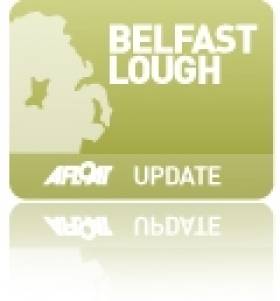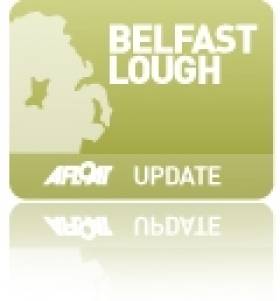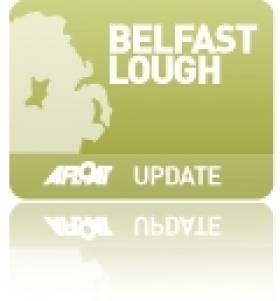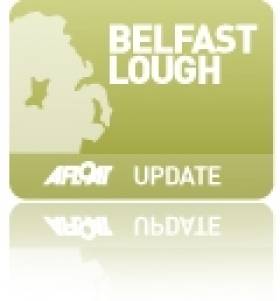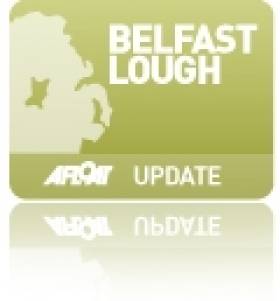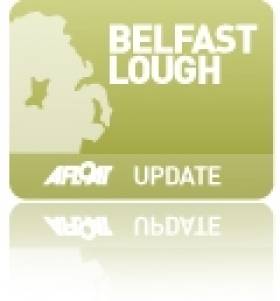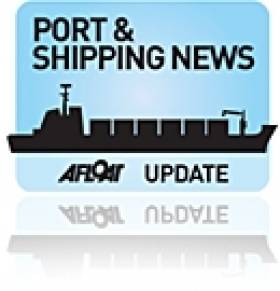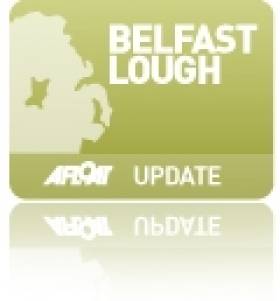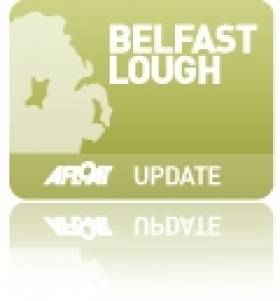Displaying items by tag: Belfast Lough News
DFDS to Shed 60 Jobs in Belfast Operation
#DFDSBelfast – Shipping and logistics company DFDS are to let go 60 jobs in Belfast at the end of this year as it shifts its finance centre to Poland.
Danish owned company DFDS said Belfast would be the first location to lose its finance department out of the 21 countries in which it operates.
The office on West Bank Road in Belfast will close in December, DFDS said. However its other Irish operations, including DFDS Logistics in Belfast and Dublin, are not affected.
For more on this story the Belfast Telegraph reports.
#CruiseBELFAST – Opening the cruiseship season to Belfast Harbour today is the small ultra-luxury Hebridean Princess, now serving her 25th year of operations, writes Jehan Ashmore.
The former west Scottish isles car-ferry Columba currently operated by Hebridean Island Cruises, is the first of 60 cruise callers to bring 100,000 visitors to the city port during 2013.
Belfast Harbour can also look forward later this month in officially marking its 400th anniversary when the port's first quay was established by a Royal Charter in 1613.
On a related royal note, Hebridean Princess was chartered by Queen Elizabeth II for a family holiday cruise around the Scottish isles to mark her 80th birthday in 2006.
The ship is berthed in Pollock Dock (see basin on left of aerial view) which is situated closer to the city-centre compared to the Stormont Wharf facility which caters for considerably larger cruiseships.
As previously reported on Afloat.ie, 2013 is set to become another breaking season, in contrast to last year's season when 44 cruiseships called carrying 75,000 passengers.
Among the cruise operators to call they include Princess Cruises, Holland America Line, Celebrity, MSC, Thomson, Fred Olsen Cruise Line and Saga Cruises. For details of calls click the LINER-LIST.
£50m Offshore Wind Terminal Completed in Belfast Harbour
#BelfastWindTerminal - A new £50m offshore wind terminal which has been completed in Belfast Harbour, has been handed over to DONG Energy and ScottishPower Renewables.
As previously reported on Afloat.ie, the terminal, the first purpose-built offshore wind installation and pre-assembly harbour in the UK or Ireland, will be used as a hub to help service a market valued in excess of 100bn. Up to 300 jobs are expected to be created, ranging from welders to electricians and engineers.
The official hand-over was attended by Northern Ireland's First and Deputy First Ministers, Peter Robinson MLA and Martin McGuinness MLA, along with Len O Hagan, Belfast Harbour's Chairman and Brent Cheshire, DONG Energys UK Country Chairman.
DONG Energy has signed a lease for the terminal which will be used initially to support the development of the West of Duddon Sands Wind farm in the Irish Sea, a joint venture between ScottishPower Renewables and DONG Energy. Work on the wind farm has already started and Belfast Harbour has received its first shipment of wind farm components. Its anticipated that the first turbines will depart Belfast this summer for erection at the site.
Welcoming the handover, Len OHagan, Belfast Harbour's Chairman, said: "Delivering this immense project on time and on budget has been a major achievement. This is a historic development for Belfast which has the potential to usher in a major new industry for Northern Ireland a development which is all the more poignant given that this is the Harbours 400th anniversary year".
He added "Over the years the harbour has helped bring other industries to Belfast such as shipbuilding and aerospace by investing heavily in infrastructure and land reclamation. This is a continuation of that strategy and a demonstration of our long-term commitment to enhance the local economy".
The 50-acre terminal, located on the Co. Down side of the port, is the largest single investment in Belfast Harbours 400-year history. Built by local construction company Farrans, the project took 15-months, 750,000 man hours, one million tonnes of stones and 30,000 tonnes of concrete to complete.
The 200,000 m2 facility, large enough to accommodate 30 football pitches, includes a 480m deep-water quayside. Up to three vessels will be able to berth simultaneously with access available around the clock.
Brent Cheshire, DONG Energys UK Country Chairman commented: "Having a bespoke facility at our fingertips will help us plan our offshore construction very effectively and help with our work to lower the cost of offshore wind farms. The site is in an excellent strategic position for DONG Energy as we have several wind farms under development in the Irish Sea. This is a port that can handle the large number of huge pieces of equipment required".
Keith Anderson, ScottishPower Renewables CEO, added: "The facility at Belfast Harbour is one of the most advanced anywhere in the world for the assembly of offshore wind turbines, and we are delighted to be taking over the lease as we start offshore construction on the West of Duddon Sands project.
This marks a significant milestone for the West of Duddon Sands project, and we are sure that Belfast will play a hugely important role in its successful delivery. The investment in Belfast Harbour will ensure that the city has a long-term future as a leader in renewable energy.
Over 100 turbines, each with a rotor diameter of 120m, will be shipped from the new terminal to the West of Duddon Sands project. It will be one of the worlds largest offshore wind farms when it is commissioned in 2014.
The UK is Europes leading offshore wind generator and has plans to develop 11,000 new offshore wind turbines, a quarter of which are expected to be built within 150 nautical miles of Belfast. It is anticipated that 32 gigawatts of electricity, one quarter of the nations electricity needs, will be provided by offshore wind.
Belfast Harbour’s Tonnage Record in 2012
#BelfastHarbour – Figures released by Belfast Harbour reveal that trade handled by the port during 2012 rose to a record 19.6m tonnes, up 11% on the previous year. The growth was driven primarily by an improved performance in the bulk and roll-on / roll-off (freight vehicle) sectors.
A record 4.6 million tonnes of dry-bulk was handled, a jump of 16%. This included 2m tonnes of grain and animal feeds, the highest tonnages ever recorded by the harbour in this sector.
An additional 600,000 tonnes of coal was also handled, reflecting recent investments by the harbour in deep-water facilities which have enabled it to handle coal imports for AES's power station at Kilroot, on the northern coast of Belfast Lough. Coal imports are now in excess of 1m tonnes for the first time since 1996.
Major investments by Belfast Harbour and Stena Line in new terminals on both sides of the Irish Sea, plus a pair of new superfast ferries, have significantly enhanced the competitiveness of the Belfast – Cairnryan route.
Port Tonnages Rise by 11%
This, coupled with a record performance on the Belfast – Heysham route, helped drive the number of freight vehicles passing through the Port to 432,000, up 21% since 2011.
Commenting on the figures, Roy Adair, Belfast Harbour's CEO, commented: "It's greatly encouraging for Belfast Harbour to once again be able to report such a positive set of trade figures. Growth across a number of sectors reaffirms Belfast's position as one of the most efficient ports in these islands and helps benchmark the harbour's ongoing contribution to the Northern Ireland economy.
"Long-term investments by the harbour and by key port users such as Stena Line have delivered significant benefits to the regional economy. It is particularly pleasing that the roll-on / roll-off traffic has performed so strongly in what is one of the most competitive sectors in the port industry. "
Liquid Bulk total imports in 2012 remained steady compared with the previous year, with 2.1 million tonnes handled. Container traffic fell back by 5% to 123,000 boxes as consumer demand continued to soften. Construction related trades such as timber also continued to decline. Timber imports fell for the seventh year in a row, down by 9%.
On a more positive note, there was some indication of a recovery in activity in Northern Ireland's manufacturing base with steel imports rising by 11% to 128,000 tonnes, the highest level since 2008.
Passenger numbers using the port's ferry services also increased by 11% to almost 1.4 million, reflecting the growing popularity of 'holidays at home' and major boosts to Northern Ireland's tourist sector with the opening of Titanic Belfast and the new Giant's Causeway visitor centre. The 'Titanic' effect was even more evident in the cruise sector with 45 ships and 75,000 visitors calling at Belfast in 2012 – a rise of 40% since 2011.
Joe O'Neill, Belfast Harbour's Commercial Director added: "While the overall trend in tonnages handled is positive, the harbour is ever mindful that the wider economic outlook remains challenging. The record level of trade handled in 2012 was a direct consequence of a major investment programme; similar investments will be required for the long-term competitiveness of the port.
"For example, the trend for ever larger vessels plus Belfast's growing popularity as a cruiseship destination – bookings for 2013 are already up by over 25% - will require further investments in the port's deep water facilities to accommodate demand.
"Belfast Harbour will also continue to pursue major marine projects such as the development of a £50m, 50-acre offshore wind farm terminal for DONG Energy."
Belfast’s Record-Breaking Cruise Boost
#BelfastCruiseCalls – The 2013 season will bring a record 57 cruiseships and more than 100,000 visitors to Belfast Harbour, compared to last year when only 44 cruiseships docked with 75,000 passengers, writes Jehan Ashmore.
Tourists from all corners of the globe are to visit Northern Ireland, having booked cruises with leading operators, among them Princess Cruises, Holland America Line, Celebrity, MSC, Thomson, Fred Olsen Cruise Line and Saga Cruises. The first caller of the season is the ultra-luxury Hebridean Princess, when she is to make a port of call in April.
Last month, Cruise Critic UK, the leading source of cruise information on the web, named Belfast as 'Best UK Port of Call' in their Editors' Picks Awards 2012.
The continuing success of Belfast as a destination to an international cruise market has been built from the efforts of Cruise Belfast, a marketing initiative between Belfast Harbour and Belfast Visitor and Convention Bureau (BVCB).
Anne McMullan from BVCB said "Cruise travel globally is one of the fastest growing and highly competitive areas of tourism and the record-breaking cruise ship numbers arriving in Belfast are a testament to the city's tourism success and how far we have come".
Asides the new Titanic Belfast Centre, which has arguably done for the city what the Guggenheim did for Bilbao, the port acts as a 'gateway' to the rest of Northern Ireland, where attractions are within a short coach trip to the Giants Causeway, Mount Stewart and St Patrick's Country.
£1m to Restore Belfast’s Historic Warship
#HMS CAROLINE – The last surviving floating warship of World War I,HMS Caroline has been secured with a £1 million restoration grant.
The National Heritage Memorial Fund (NHMF) is funding the project to protect Belfast-based HMS Caroline from falling into disrepair.
This grant awarded to the National Museum of the Royal Navy (NMRN) will enable urgent repair works to the light cruiser including making the ship wind and water tight and incorporate the removal of dangerous asbestos.
To read more The Belfast Telegraph has a report.
Patrol Ship Purchased, Dublin Dry-Dockings, Belfast Port Masterplan, IMDO Launch Report, Naval and Cruiseship News
#PORTS & SHIPPING REVIEW - Over the last fortnight Jehan Ashmore has reported from the shipping scene where the Royal Navy's fishery patrol vessel HMS Mersey docked in Dublin Port, having been purchased from her shipbuilder-owners as part of a £39m deal.
One of the largest vessels of the Arklow Shipping Ltd fleet, Arklow Manor of 9,682grt/14,008dwt arrived in Dublin Port to enter the dry-dock facility, one of her sisters had also used the dry-dock in Alexandra Basin earlier this year.
P&O Cruises Adonia, became the final cruise caller to Dublin Port this year, having spent a day at sea after departing Cobh Cruise Terminal the previous day. She led the fleet during the 175th anniversary 'Grand Event' which formed one of the lectures during last month's London Ship Show.
A Masterplan setting out the future for the next 20-30 years for Belfast Harbour was launched, those interested in making comments on the plans are asked to respond by 7 December.
The Irish Maritime Development Office (IMDO) released a report of the nine semi-state port's financial statements for the year end 2011. A key finding is that after a combined growth of 3% in turnover in 2010, the ports recorded a fall in turnover of 3% in 2011 with turnover falling to €120m.
Naval Service OPV L.E. Emer (P21) detained an Irish fishing vessel off the south-east coast over alleged breaches of fishing regulations and was escorted to Cork and handed over to the Gardai.
In 2013 Cruise & Maritime Voyages are to charter Discovery (1971/20,216grt) for the UK cruising season. She is scheduled to make her debut 'Irish' port of call to Dublin Port in April, which will also mark the start of the cruise season to the capital.
Belfast Harbour Launch Masterplan
#BELFAST PORT – Plans for the future of Belfast Harbour has been outlined for the next 20-30 years with the publication of a Masterplan.
Interested parties are invited to download the document from the port's website. Those parties wishing to offer commentary on the plans are asked to follow the response instructions at the end of the document and provide comments before 7 December 2012.
An improved performance in both turnover and profits were recorded during 2010-2011. According to the harbour's annual report a 2% rise was achieved in profit before taxation to £17.8m and a 4% increase in turnover totalled £36.1m
AGM of Belfast Harbour
#PORT AGM – The annual general meeting of Belfast Harbour is to take place at the Harbour Office, Corporation Square, during the morning of 23 October between 09.45 -10.45.
As previously reported, Belfast Harbour recently unloaded its single largest ever cargo shipment of 56,000 tonnes of coal, which broke all records to date, over the ports 400 year long history.
According to the port, around 60% of the north's seabourne trade and 20% of the entire island's is handled at the harbour, handling around 17m tonnes of cargo per annum and where approximately 5,500 vessels call each year.
Belfast Lough Deepened for Record Breaking 'Cargo' Ship
#BELFAST LOUGH- The record for the largest single cargo shipment to Belfast Harbour over its 400-year history was broken last Saturday, reports The Belfast Telegraph.
The record was set by the bulk carrier 'Royal Breeze' which was laden with 56,000 tons of coal, having sailed across the Atlantic from Virginia. The vessels mammoth tonnage dwarves the previous largest cargo to arrive at the port of 41,000 tons and follows the deepening of Victoria Channel in Belfast Lough to cater for such large vessels.
The coal is destined for AES UK's Kilroot power station and was unloaded by the harbour's newest crane, the £2.8m, 40m Gottwald - the largest crane in use in any UK or Irish port.


























